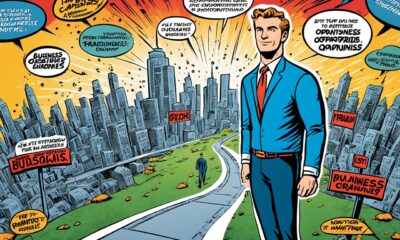Growing a Business
Founder's Mental Struggles After Bagel Boom
In the wake of the bagel boom, founders face daunting mental struggles—discover how to navigate this turbulent landscape and reclaim your confidence.

After the bagel boom, you might feel overwhelmed by pressure and burnout. Many founders experience anxiety as they navigate high demands. The lack of community support can lead to feelings of isolation and loneliness. As you push through work without breaks, burnout can reduce your productivity. You might also struggle with fear of failure and imposter syndrome, which can erode your confidence and paralyze decision-making. To combat these struggles, it's essential to develop coping strategies, seek support, and prioritize your mental health. There's more to discover about overcoming these challenges and thriving in the entrepreneurial landscape. Seeking out mentorship and building a strong network of peers can provide valuable insight and emotional support. Additionally, prioritizing self-care and mental wellness advocacy within your workplace can create a more supportive and sustainable environment for yourself and your team. It’s important to recognize the signs of burnout and anxiety, and take proactive steps to address them in order to maintain a healthy work-life balance.
Key Takeaways
- High demands and pressures following the success led to increased anxiety levels for Elyse and Nick Oleksak.
- The isolation from a lack of community support contributed to feelings of loneliness post-acquisition.
- Overworking without breaks resulted in burnout, significantly reducing their productivity and overall well-being.
- Constant fear of failure created pressure that paralyzed decision-making and eroded their confidence.
The Rise of Bantam Bagels
Bantam Bagels skyrocketed to success after Elyse and Nick Oleksak transformed their bite-sized snack idea into a beloved brand featured on Shark Tank. You can imagine the excitement when they secured $275,000 for 11% equity from Lori Greiner in 2014.
This pivotal moment propelled them into the spotlight, leading to impressive sales that reached $45 million. As their mini bagels stuffed with cream cheese gained popularity, they expanded to 10,000 stores and 8,500 Starbucks locations.
In 2018, they sold the brand to T. Marzetti for $34 million, marking a strategic move for future growth. Despite the brand's eventual halt in operations in 2022, its legacy remains a tribute to entrepreneurial innovation and determination.
Mental Health Challenges Faced

Facing the unexpected pressures of success, Elyse Oleksak encountered significant mental health challenges that reshaped her entrepreneurial journey. You might find it relatable when success leads to overwhelming stress and anxiety. The constant state of panic can result in a breakdown, making therapy a vital lifeline for recalibration. Here's a look at some common mental health challenges faced by entrepreneurs like Elyse:
| Challenge | Description | Impact |
|---|---|---|
| Stress | High demands and responsibilities | Increased anxiety levels |
| Isolation | Lack of community support | Feelings of loneliness |
| Burnout | Overworking without breaks | Decreased productivity |
| Fear of Failure | Constant pressure to succeed | Paralysis in decision-making |
| Imposter Syndrome | Doubts about self-worth | Erosion of confidence |
Coping Strategies and Support

To navigate the mental health challenges that often accompany entrepreneurial success, implementing effective coping strategies and seeking support is essential. You can start by embracing a few key practices:
- Establish a routine: Consistent daily rituals can provide structure and reduce feelings of chaos.
- Connect with others: Engage with fellow entrepreneurs or support groups to share experiences and foster community.
Don't hesitate to reach out for professional help when needed. Therapy can offer valuable tools for managing stress and anxiety.
Lessons From the Journey

Reflecting on the entrepreneurial journey reveals valuable lessons that can guide future business endeavors. You'll find that documenting your experiences can help others avoid similar pitfalls. Emphasizing connections made along the way is essential, as they foster support and collaboration. Here's a quick overview of key lessons:
| Lesson | Insight | Application |
|---|---|---|
| Embrace Mistakes | Learn and adapt from failures | Iterate and pivot your strategy |
| Prioritize Mental Health | Balance work and personal well-being | Seek therapy and community support |
| Cultivate Relationships | Build a network for guidance | Attend events and engage online |
Educational Impact and Innovation

Building on the lessons learned in entrepreneurship, it's clear that education plays a vital role in shaping future innovators and problem-solvers. By fostering creativity and critical thinking, educational systems can empower students to tackle real-world challenges.
Hands-on projects can bridge theory and practice, igniting passion for entrepreneurship.
Mentorship programs connect students with experienced entrepreneurs, providing guidance and insights.
Integrating mental health awareness in curricula helps future founders navigate stress and anxiety.
These educational initiatives not only prepare students for successful careers but also cultivate resilience and adaptability. As you embrace these concepts, you'll see how innovation thrives in supportive learning environments, ultimately shaping a brighter future for aspiring entrepreneurs.
Market Trends and Opportunities

Emerging market trends reveal significant opportunities for entrepreneurs willing to adapt and innovate in response to changing consumer demands. Focusing on niches like eco-friendly products, health and wellness, and technology-driven businesses can lead to success. As mobile optimization and voice search gain traction, you must prioritize user experience and content quality.
Here's a snapshot of current market trends:
| Trend | Opportunity |
|---|---|
| Eco-Friendly Products | Growing consumer demand for sustainability |
| Health and Wellness | Increased focus on personal well-being |
| Technology Integration | Need for innovative tech solutions |
| Remote Work Solutions | Services catering to a distributed workforce |
| Personalization in Marketing | Tailored experiences for consumers |
Future Aspirations and Goals

As you explore new market trends, it's important to set clear future aspirations and goals that align with your vision for success.
Defining these objectives can help you maintain focus and motivation as you navigate the ever-changing landscape of entrepreneurship.
- Document your journey: Share insights from your experiences to inspire others.
- Support small businesses: Use your knowledge to guide emerging entrepreneurs on their paths.
Conclusion
As you navigate your entrepreneurial journey, remember that mental health is just as essential as your business success. A surprising statistic shows that nearly 72% of entrepreneurs experience mental health challenges, often feeling isolated in the process.
By fostering community support and implementing coping strategies, you can combat these feelings and maintain your well-being.
Embrace the reality that success comes with struggles, and prioritize your mental health to sustain your passion and drive in the world of business.
Growing a Business
Mastering Customer Retention for Business Success
Navigating the complexities of customer retention can unlock unprecedented growth for your business—discover the strategies that can make all the difference.

Mastering customer retention is essential for your business's success and growth. It's often cheaper to keep existing customers than to acquire new ones. You can enhance retention by understanding customer needs and offering tailored upsell opportunities. Designing an engaging loyalty program can encourage repeat purchases and build trust. Additionally, exceptional customer service makes a big difference in how customers perceive your brand. By measuring key metrics like customer churn and lifetime value, you can track your progress. Discover how to implement these strategies effectively and watch your business thrive.
Key Takeaways
- Prioritize customer retention as it is more cost-effective than acquiring new customers, ensuring long-term sustainability and profitability.
- Implement effective upselling strategies by understanding customer needs and offering complementary products that enhance their initial purchases.
- Design loyalty programs with clear rewards and achievable milestones to encourage repeat purchases and customer engagement.
- Enhance customer service by actively listening to concerns, personalizing interactions, and ensuring prompt resolutions to build trust and loyalty.
Importance of Customer Retention
Customer retention is essential because it costs considerably less to keep existing customers than to acquire new ones.
When you focus on retaining your current customers, you're building on the trust they've already established with your brand. This trust opens doors for upselling, as customers are more likely to evaluate additional products or services that enhance their experience.
Offering complementary items can deepen relationships and increase your revenue. Sometimes, businesses even sell initial products at a loss to attract a customer base, planning strategic upsells for later.
Strategies for Effective Upselling

Focusing on effective upselling strategies can greatly enhance your customer retention efforts and boost revenue from your existing clientele.
Start by understanding your customers' needs and preferences; this knowledge allows you to recommend relevant products or services. Offer complementary items that enhance their initial purchase, creating added value. Position higher-ticket items as premium options to elevate their experience.
Timing is key; suggest upsells during the purchase process or shortly thereafter, while their interest is high. Make the upsell process seamless—use persuasive language that highlights benefits without being pushy.
Ultimately, train your staff to recognize upselling opportunities and engage customers naturally, ensuring they feel valued rather than pressured.
Designing Loyalty Programs

To create an effective loyalty program, you need to clearly define the rewards and benefits that will resonate with your target audience. Consider what motivates your customers—whether it's discounts, exclusive access, or points redeemable for future purchases.
Next, set achievable milestones that encourage engagement, making sure the rewards feel attainable yet valuable. Keep communication transparent; let customers know how they can earn points and redeem rewards.
Also, implement a tiered structure to incentivize higher spending, giving loyal customers more reasons to stay engaged. Regularly evaluate and adapt your program based on customer feedback and behavior data, ensuring it evolves with your audience's needs and preferences.
This way, you'll foster long-lasting relationships and enhance customer retention effectively.
Enhancing Customer Service

Excellent service builds trust and loyalty, ensuring your customers keep coming back for more.
To enhance your customer service, focus on these key strategies:
- Listen actively: Understand your customers' needs and concerns by giving them your full attention.
- Train your team: Equip your staff with the skills and knowledge to address issues effectively and empathetically.
- Be responsive: Address inquiries and complaints promptly, showing your customers that you value their time.
Measuring Retention Success

Measuring retention success involves analyzing key metrics that reveal how well your business keeps customers engaged and satisfied over time. To effectively gauge your retention efforts, focus on metrics such as customer churn rate, repeat purchase rate, customer lifetime value, and net promoter score.
Here's a simple overview of these metrics:
| Metric | Description |
|---|---|
| Customer Churn Rate | Percentage of customers lost over a specific period |
| Repeat Purchase Rate | Frequency of customers returning to make purchases |
| Customer Lifetime Value | Total revenue expected from a customer during their relationship |
| Net Promoter Score | Measure of customer loyalty and satisfaction |
Conclusion
Mastering customer retention isn't just beneficial; it's essential for your business's success.
Did you know that increasing customer retention rates by just 5% can boost profits by 25% to 95%?
By implementing effective upselling techniques, creating engaging loyalty programs, and prioritizing exceptional customer service, you can transform one-time buyers into lifelong advocates.
Start focusing on these strategies today, and watch your customer relationships flourish, leading to sustainable growth and profitability in the long run. By prioritizing open communication, personalized service, and consistent follow-up, you’ll build trust and loyalty that sets your business apart from the competition. In an era where news like “wine company collapse shocks customers” can cause uncertainty and shake consumer confidence, having strong relationships with your clientele will help you weather any storm. Cultivating these connections provides a solid foundation for long-term success, even in challenging markets.
Growing a Business
Branding: Product First or Core Values
Can a brand thrive by prioritizing products over core values, or is the true key to success hidden in a delicate balance?

When considering branding, it's essential to balance product features and core values. You want your products to stand out, but your brand's identity should reflect what you believe in. Strong brands often lead by highlighting their unique value proposition, which resonates with consumer perceptions. Your core values can create trust and foster loyalty, while your products must meet consumer needs effectively. Focusing on both aspects helps secure a solid market position. Remember, understanding this balance is key to long-term success and recognition in the marketplace, and there's more to explore about effective strategies.
Key Takeaways
- Successful branding often balances product offerings with core values, ensuring alignment with consumer perception and expectations.
- A strong brand foundation emphasizes unique value while integrating core values to resonate with target audiences.
- Early marketing should reflect both product design and the brand's core values to avoid misalignment with consumer needs.
- Brands that prioritize core values can foster trust and loyalty, enhancing long-term success in the marketplace.
Understanding Branding Essentials
Branding essentials start in your prospect's mind, shaping how they perceive your product and its place in the market.
To build a successful brand, you need to understand that it often revolves around pioneering new categories. Think about Google in search or Coca-Cola in soft drinks; they've set the standard.
Your goal should be to own a specific category in the consumer's perception, whether that's as a leader, number two, or even an also-ran.
Focus on the unique value you bring, which differentiates your brand.
Remember, it's not just about what you sell, but how you're seen in the minds of consumers.
Establishing a strong brand foundation is vital for long-term success and recognition.
Navigating Market Positioning

To navigate market positioning effectively, you need to clearly define where you want your brand to stand in relation to competitors. Consider your unique value proposition and how it differentiates you in the market. Here's a simple table to help you visualize your positioning strategy:
| Positioning Strategy | Example Brands | Key Differentiator |
|---|---|---|
| Market Leader | Coca-Cola | Brand heritage |
| Strong No. 2 | Pepsi | Innovative flavors |
| Niche Player | LaCroix | Health-focused offerings |
| Emerging Challenger | Spindrift | Unique fruit flavors |
Role of Early Marketing

Early marketing plays an essential role in shaping product design and production, ensuring that consumer needs and perceptions guide development from the outset.
By engaging with potential customers early on, you gather valuable insights that inform your product strategy. This proactive approach helps you avoid costly missteps, as it aligns your offerings with market demand.
Consulting with marketing experts can enhance your understanding of consumer behavior, allowing you to craft a compelling message that resonates. By gaining insights from their expertise, you can identify key trends and tailor your approach to better meet your audience’s needs. With digital marketing strategies demystified, navigating the complexities of online platforms becomes more accessible, empowering you to make data-driven decisions. This targeted approach ensures that your messaging not only reaches the right people but also drives meaningful engagement.
Moreover, achieving first-mover advantage can set you apart, as seen with Chobani's rise in the Greek yogurt market.
Strategies for New Entrants

Understanding how to position your brand effectively is essential for new entrants in a competitive market. Start by identifying a niche where you can differentiate yourself from existing players.
You've got two main strategies: create a new category or narrow your focus. For instance, if you're entering a saturated market, consider targeting a specific consumer need that isn't being met.
Look at brands like Earth's Best and Silk, which successfully carved out new categories. Alternatively, if you can't create a new category, hone in on a particular aspect of your product, like BMW did with driving performance.
Aligning Consumer Perception

Aligning your brand with consumer perception is essential for achieving lasting success in the marketplace. You need to understand how consumers view your brand and guarantee that your messaging resonates with their values and expectations. This alignment creates trust and loyalty, ultimately driving sales. Here's a simple framework to help you assess your brand alignment with consumer perception:
| Aspect | Consumer Expectation |
|---|---|
| Quality | High standards of excellence |
| Innovation | Cutting-edge solutions |
| Trustworthiness | Transparency and honesty |
| Customer Service | Responsive and helpful support |
| Social Responsibility | Commitment to ethical practices |
Conclusion
In the vibrant tapestry of branding, your product and core values are the threads that weave together your identity.
By prioritizing both, you create a masterpiece that captivates your audience's hearts and minds.
As you begin this journey, remember that a brand isn't just a name; it's a story that resonates.
So, whether you're crafting a sleek gadget or a heartfelt mission, let your values shine through, guiding you to a lasting connection with consumers.
Growing a Business
Leonard Riggio: Revolutionizing Book Retail
Leonard Riggio's innovative approach to book retail transformed shopping into a cultural experience, but what challenges did he face along the way?

Leonard Riggio revolutionized book retail by transforming the shopping experience into a cultural outing. Starting as a clerk, he expanded the Student Book Exchange and later acquired Barnes & Noble, where he introduced superstores. You'll find comfortable seating and coffee, creating inviting spaces for exploration. Riggio's customer-centric approach combined innovative features like discount strategies and the Sales Annex, redefining how you engage with books. Despite facing criticism from independent bookstores, he emphasizes adapting to technology for the future. You'll see how his vision might shape the next chapter in the book retail industry.
Key Takeaways
- Leonard Riggio transformed book retail by acquiring Barnes & Noble and introducing a customer-centric superstore model.
- He created inviting spaces with seating and coffee services, making bookstores cultural hubs for relaxation and exploration.
- Riggio's innovative retail strategies included aggressive discounting and showcasing remaindered books, attracting a loyal customer base.
- His approach sparked criticism from independent bookstores, highlighting challenges in maintaining market competition.
Early Career Beginnings
Leonard Riggio kicked off his bookselling journey in the early 1960s as a clerk at the NYU bookstore, where he discovered his passion for the industry. You can imagine the excitement he felt surrounded by books and enthusiastic students.
After dropping out of college at 24, he took a bold step by investing $5,000 to open the Student Book Exchange (SBX) in 1965. His vision extended beyond just selling books; he aimed to create a community hub for students.
As SBX thrived, expanding to four additional campus bookstores in NYC, Riggio's determination set the stage for a remarkable career in retail. This foundational experience shaped his approach to bookselling, blending commerce with a genuine love for literature.
Expansion of SBX and Barnes & Noble

The success of the Student Book Exchange (SBX) quickly led to its expansion across multiple campuses in New York City, ultimately paving the way for Riggio's acquisition of Barnes & Noble in 1971, which transformed the book retail landscape.
You'd notice that SBX's innovative approach attracted a loyal customer base, making it an attractive opportunity for Riggio.
After acquiring Barnes & Noble for $1.2 million, he shifted its focus from traditional retail to a more modern, customer-centric model. This move not only expanded his influence but also set the stage for future growth.
Innovations in Book Retailing

With the acquisition of Barnes & Noble, Riggio transformed traditional bookselling by introducing innovative retail concepts that turned bookstores into vibrant community spaces.
He redefined the shopping experience by creating superstores, filled with comfortable seating and coffee services, inviting customers to linger. You'll find an entertainment vibe in these spaces, where browsing books feels more like a relaxing outing than a chore.
Riggio also embraced mass-market retailing, employing aggressive discount strategies that attracted a broader audience. The Barnes & Noble Sales Annex showcased remaindered books and free newspapers, enhancing foot traffic and customer engagement.
This shift not only boosted revenue but also established bookstores as essential cultural hubs, redefining how you perceive and interact with literature.
Customer Experience Transformation

Transforming customer experience, Riggio focused on creating inviting spaces where you could relax, explore, and enjoy books like never before. He understood that a bookstore shouldn't just be a retail space; it should feel like a community hub.
By introducing comfortable seating and coffee services, he turned Barnes & Noble into a destination for readers. You could spend hours browsing, sipping coffee, and discovering new titles in a cozy atmosphere.
Riggio's vision extended beyond mere transactions; he aimed to enhance your connection to literature. The superstore model didn't just increase sales; it redefined how you experienced shopping for books, making it a pleasurable outing rather than a chore.
This transformation laid the groundwork for a new era in book retail.
Industry Challenges and Criticism

While Riggio's innovations in creating inviting bookstore environments garnered praise, they also sparked significant criticism from independent bookstores facing challenges in the evolving retail landscape.
You might feel the tension as these smaller shops struggled to compete with Barnes & Noble's superstore model, which dominated the market.
Critics argue Riggio's approach pressured publishers into exclusive deals, limiting choices for consumers and stifling diversity in the industry.
You can see how independent booksellers, often community-focused, faced hurdles in maintaining their customer base amidst aggressive pricing and marketing strategies.
This disruption led to a broader conversation about the future of bookselling, raising questions about sustainability and the potential loss of unique voices in literature as larger chains continued to expand their reach.
Vision for the Future

Envisioning a future shaped by technological advancements, Riggio anticipates a significant evolution in the publishing landscape, focusing on the integration of online services for accessing books.
He believes that the way readers discover and interact with literature will transform through digital platforms, creating a more personalized experience. You can expect features like instant access to a vast library, interactive content, and tailored recommendations based on your preferences.
Riggio sees this shift not just as a convenience but as a means to foster a deeper connection between readers and authors. By embracing these innovations, you'll find that bookstores will likely evolve into hybrid spaces, blending the physical and digital domains to enrich your reading journey and community engagement.
Adapting to Technological Change

As the publishing landscape evolves, bookstores must adapt to technological changes that enhance the reader experience and streamline access to literature. Embracing these innovations is vital for staying relevant.
Here are some key strategies you can implement:
- Integrate e-commerce: Optimize your website for online sales and inventory management.
- Utilize social media: Engage with your audience through platforms like Instagram and Facebook.
- Offer digital content: Provide eBooks and audiobooks to cater to diverse reading preferences.
- Incorporate technology in-store: Use tablets for browsing or self-checkout stations to improve efficiency.
Conclusion
Leonard Riggio's journey is a tapestry woven with ambition and innovation, transforming the book retail landscape into a vibrant marketplace.
He didn't just open stores; he crafted inviting havens for readers, where books and community intertwined like threads in a quilt.
As the pages of the industry turn, his visionary approach continues to inspire, reminding us that adaptability and foresight can illuminate even the darkest corners of change. His ability to anticipate trends and pivot when necessary has solidified his reputation as a forward-thinking trailblazer in the field. Whether navigating through uncharted territories or addressing unforeseen challenges, his track record speaks volumes. In a rapidly evolving landscape, “hitandrun claims wellness leader,” echoing the speed and precision at which he has managed to redefine industry standards while ensuring collective well-being remains a top priority.
Riggio's legacy is a beacon for the future of book retailing.
-

 Startup Stories and Case Studies4 months ago
Startup Stories and Case Studies4 months agoStartup Stories and Case Studies: Learn from Success
-

 Franchises4 months ago
Franchises4 months agoSweet Success: The Nothing Bundt Cakes Franchise
-

 Franchises4 months ago
Franchises4 months agoExploring Franchises: Your Path to Business Ownership
-

 Business Planning4 months ago
Business Planning4 months agoCraft a Robust Business Plan: Your Guide to Success
-

 Business Planning4 months ago
Business Planning4 months agoDefine Your Products and Services: A Crucial Step
-

 Funding4 months ago
Funding4 months agoUnderstanding How Startup Funding Works
-

 Business Planning4 months ago
Business Planning4 months agoAnalyze Your Competitors: Gain a Competitive Edge
-

 Franchises2 months ago
Franchises2 months agoTaco Bell's CEO Redefines Leadership Norms



























